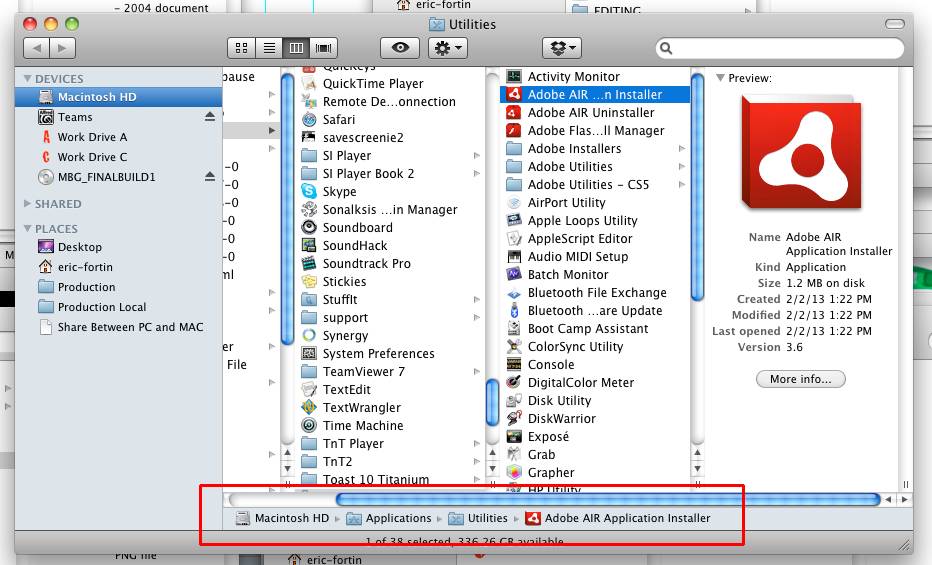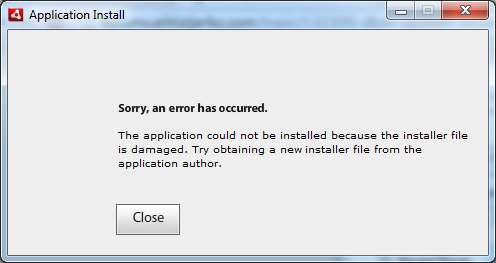Adobe Air Installer For Mac
To install or update the runtime, a user must have administrative privileges for the computer.
Install the runtime on a Windows computer
Download the runtime installation file from http://get.adobe.com/air.
Double-click the runtime installation file.
In the installation window, follow the prompts to complete the installation.
Install the runtime on a Mac computer
Download the runtime installation file from http://get.adobe.com/air.
Double-click runtime installation file.
In the installation window, follow the prompts to complete the installation.
If the Installer displays an Authenticate window, enter your Mac OS user name and password.
Install the runtime on a Linux computer
Download and install Adobe AIR in PC and you can install Adobe AIR 25.0.0.134 in your Windows PC and Mac OS. Adobe AIR is developed by Adobe and listed under TOOLS. If you are looking to install Adobe AIR in PC then read the rest of the article where you will find 2 ways to install Adobe AIR in PC using BlueStacks and Nox app player however you.
Using the binary installer:
Locate the installation binary file from http://kb2.adobe.com/cps/853/cpsid_85304.html and download.
Set the file permissions so that the installer application can be executed. From a command line, you can set the file permissions with:
Some versions of Linux allow you to set the file permissions on the Properties dialog opened through a context menu.
Run the installer from the command line or by double-clicking the runtime installation file.
In the installation window, follow the prompts to complete the installation.

Adobe AIR is installed as a native package. In other words, as rpm on an rpm based distribution and deb on a Debian distribution. Currently AIR does not support any other package format.
Using the package installers:
Locate the AIR package file from http://kb2.adobe.com/cps/853/cpsid_85304.html. Download the rpm or Debian package, depending on which package format your system supports.
If needed, double-click AIR package file to install the package.
You can also install from the command line:
On a Debian system:
On an rpm-based system:
Or, if you are updating an existing version (AIR 1.5.3 or later):
Adobe Air Silent Install Mac
Installing AIR 2 and AIR applications requires you to have administrator privileges on your computer.
Adobe Air Download For Windows 10
Adobe AIR is installed to the following location: /opt/Adobe AIR/Versions/1.0
AIR registers the mime-type 'application/vnd.adobe.air-application-installer-package+zip', which means that .air files are of this mime-type and are therefore registered with the AIR runtime.

Install the runtime on an Android device
You can install the latest release of the AIR runtime from the Android Market.
You can install development versions of the AIR runtime from a link on a web page or by using the ADT -installRuntime command. Only one version of the AIR runtime can be installed at a time; you cannot have both a release and a development version installed.
See ADT installRuntime command for more information.
Install the runtime on an iOS device
The necessary AIR runtime code is bundled with each application created for iPhone, iTouch, and iPad devices. You do not install a separate runtime component.
As Adobe has focused on Flash Player development in the aftermath of the rise of HTML5, it hasn't ignored its other content-delivery system: Adobe AIR. AIR 3 brings some hefty speed improvements to the system, thanks to a little something new called Stage3D.
In case you're new to AIR, which means Adobe Integrated Runtime, it's a platform that runs applications across multiple systems without coding in more than one language. It's powerful and respected for giving people the same end-user experience, whether on Windows, Mac, or Linux. One very well-known AIR app is TweetDeck. If you try to install an AIR app without having previously installed AIR, you'll be automatically prompted to download it.
Stage3D brings combined hardware-accelerated 2D and 3D graphics rendering that's up to 1,000 times faster than previous versions of AIR. Although it's only for desktops at the time of writing, Adobe promises that it will soon take Stage3D to its mobile apps. The advancements offered by Stage3D should bring far more complex graphics development for the player, and allow some developers to use it as a viable alternative for their projects, especially for cross-platform efforts. It includes more support for Android devices including software licensing and hardware, captive runtime support for developers to bundle AIR along with their programs (removing the requirement to separately install AIR), and native extensions for enhancing AIR's capabilities.
AIR has allowed developers to make hybrid applications, or desktop tools that can integrate with various Web services, while still allowing some offline functionality that Web browsers don't yet have. This includes things like taskbar and dock notifications. With these latest updates, Adobe is really improving AIR as an alternative development environment and maintaining its relevance on the Web.